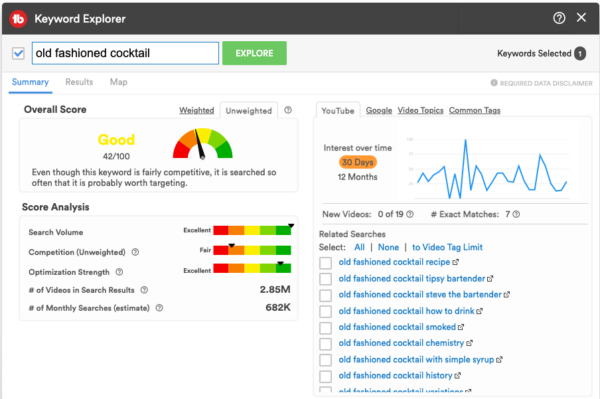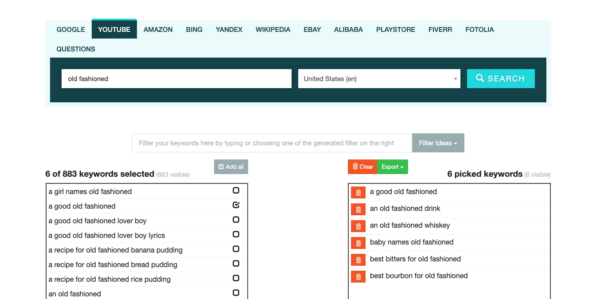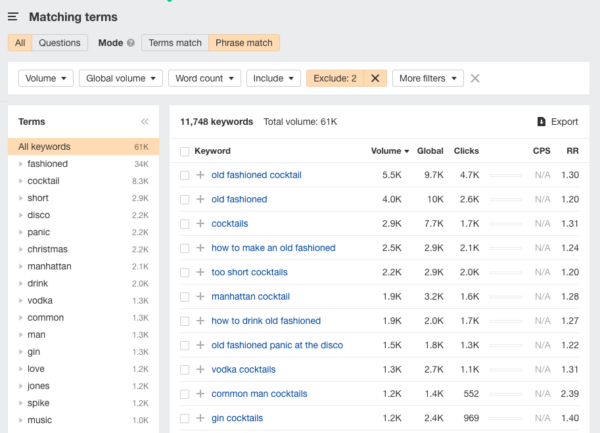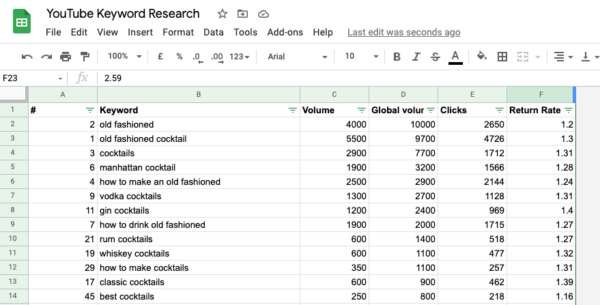How to do keyword research for YouTube

Keyword research for YouTube SEO is a very different process than keyword research for Google and Bing. However, too often marketers take the research they’ve done for Google and apply the learnings directly to YouTube. This never quite works, because the things people search for on YouTube differs greatly from the kind of things they search for on other search engines. That’s why you need to approach YouTube keyword research differently. In this post, we’ll discuss how!
YouTube is a search engine, but people use it differently than they use Google. For starters, every search on YouTube has a video intent. There are also more implied questions, broader topic queries and regularly repeated queries (where the expectation is that results change frequently).
That’s why you should conduct YouTube keyword research in addition to the keyword research for your content pages. By acquiring and analyzing the date in advance of creative ideation you can ensure your YouTube strategy is likely to drive a large number of views over an extended period of time.
In this post, we offer a five-step approach to YouTube keyword research. Including a mixture of free and paid tools that will give you an actionable framework you can use straight away.
Step 1: Collect your list of topics
First off, you need to collect a list of all the topics that you could create video content about. Your existing keyword list can be the starting point for this. But be sure to think laterally and within the context of YouTube. In practice, this means removing most of the navigational and transactional queries from your keyword list and instead focusing on the informational queries.
When we search on YouTube, we’re looking for a video that relates to a certain entity, covers a certain topic, or solves a specific problem. We’re probably not looking to find a website, purchase a product or find directions. For example, searches for actual product categories tend to be low on YouTube, but searches for “[specific product]+ review” tend to be quite high.
There is a lot of cross over between high volume YouTube queries and queries that contain videos in Google search. So one way of quickly and effectively refining your keyword list is by those that include video SERP features (this information is provided by Stat, SEMrush, Ahrefs, and other popular keyword tools).
Use the expertise in your team
In addition, Google Trends, YouTube autosuggest, and analysis of competing YouTube channels can give you inspiration about the topic areas available. However, I think often the most auspicious route to finding terms to act as your seed list is by surveying your team. By finding out what they know and could contribute videos about.
Internal expertise is often the best starting point for building a YouTube content plan as you can match the knowledge you have internally to the latent demand externally. Remember that YouTube is as much a social network as a search engine. The best ideas for content are not always those inspired by keyword data!
Step 2: Generate keyword ideas
Once you’ve got a topic list and ideas the next step is to expand and refine these into a list of keywords you can optimize for. There are a number of useful tools to do this:
Tube Buddy
Tube Buddy Keyword Explorer is one of the best free tools available for this step. Here you can put in one of your topic ideas and you’ll receive estimated search volume, weighted and unweighted competition scores. Based on how relevant your channel is for the term in question. But you also get a list of related searches, which you can then explore and add to your keyword list.

ahrefs
My favorite paid tool for YouTube keyword research is Ahrefs. It’s very useful for this process of expansion and refinement. With Ahrefs you can explore by both terms and phrase match (use phrase match for topics with two words or more), group and export ideas, as well as view a relative metric for “return rate” which indicates whether or not this is a term that the same user will regularly search for.

vidIQ
Another paid tool that provides search volume and opportunity score metrics aswell is vidIQ. It also gives you a snapshot of the videos that are currently trending related to the provided keywords.


The data provided here is of similar quality and detail to the data you get from TubeBuddy. But the benefit is that you can export everything to a database or spreadsheet.
Keyword.io
A useful freemium tool for this stage in theprocess is Keyword.io. As you can quickly find a list of relevant YouTube keywords and then export them for processing later.

Only the paid version of the tool gives you search volume estimates. However, the free version is still very helpful for generating and exporting more ideas.
YouTube traffic sources report
The report for “YouTube search” under traffic sources in YouTube Analytics is the only place you’ll get direct data from Google about search behavior on YouTube. Unfortunately, no search volumes are available. But you can see the keywords which are currently driving views to your existing videos. And how many impressions and views each keyword is bringing in.
This can serve as a great way to find new opportunities. Let’s say a keyword is driving a lot of views but you haven’t created a specific video for it. This is a great indicator that you may get even better results by creating content to target it.

Step 3: Get search volume data
The next step of your YouTube keyword research is to get search volume data for each of your keyword ideas. After that you can refine the list to include only those with significant enough search volume to represent a valuable opportunity. The only tool which I think is currently set up to do this at scale is ahrefs, as it allows you to input a long list of queries, add additional recommended options, and then export keyword volume for everything.
So, take your list into ahrefs, go through the full list, add any new ideas that seem relevant and remove any that don’t. Then export the data, and bring everything into Google Sheets or Microsoft Excel.


Sort the data by global or local volume (as appropriate, depending on your target audience). Then you can remove all the keywords which don’t have a large number of searches. As a general rule of thumb, anything that has fewer than 100 global monthly searches is too low to worry about.
You should now have a list of relevant, validated keywords for YouTube, sorted by search volume. Dependent on the task at hand, this might serve as sufficient to make some strategic decisions about your content strategy! However, if you have time and really want to validate the creative opportunities available, you can go a step further. By applying a video quality lens onto the keyword data in order to work out which ideas to prioritize.
Step 4: Assess the average ranking video quality
This step requires considerable time and energy. So it’s best saved until you’ve refined your potential keyword list as much as possible using other factors. The goal is to work out how competitive each query is on a qualitative level.
Go to YouTube.com and type in your target query, then watch each of the top 5-10 ranking videos. After you’ve seen them, make a qualitative assessment regarding how good the videos were on average and provide an overall score out of 10. If there was one good video and the rest of the content was low quality and dated, then give it a 4 or a 5. If everything was extremely engaging and well-produced, give it an 8 or a 9. But if the need of the searcher really isn’t being met by the content available, go with a 2 or 3.
The data here doesn’t need to be too precise, as its job is to provide a relative guide to creative competition. Which can then be used to calculate a compound metric that measures opportunity. If there are a lot of great videos already meeting the searcher’s need, you probably won’t be able to generate traction by making another similar video to the existing offerings. But if there is a demand without good content serving it, this represents an opportunity you should take advantage of.
Step 5: Generate an opportunity score
Finally, we can create a YouTube opportunity score, to judge the potential value of each keyword for our channel. Divide the search volume by the average video quality, and use this as a guide for which videos to create.

Once you’ve got this in place, you should have a list of prioritized, valuable creative opportunities that can inform your YouTube strategy. This means that you can get started with your filming!
To conclude
Because people use YouTube a bit differently from Google, you should invest some time in keyword research for YouTube. Although your existing keyword research list can serve as inspiration, you need to be mindful of which ones will work on YouTube. And which ones won’t. In this post, we’ve mentioned a few tools that you can use to do your keyword research for video SEO.
If you want to dive deeper into the stats, check out our post on how to use analytics for your video strategy. Or read more on how to timestamp your videos to get Key Moments from your videos in the search results:
Read more: How to timestamp YouTube videos and create Key Moments »
Disclosure: this blog post contains sponsored links.

